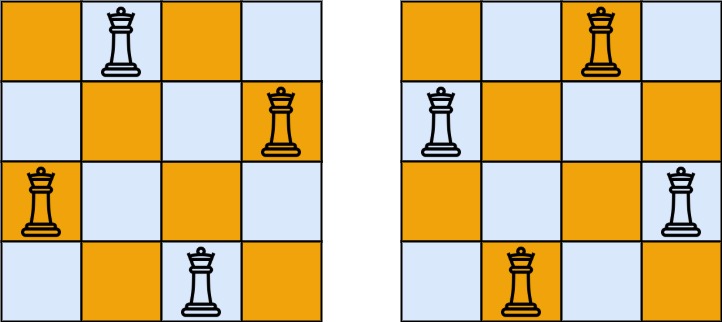The n-queens puzzle is the problem of placing n queens on an n x n chessboard such that no two queens attack each other.
Given an integer n, return the number of distinct solutions to the n-queens puzzle.
Example 1:

Input: n = 4 Output: 2 Explanation: There are two distinct solutions to the 4-queens puzzle as shown.
Example 2:Input: n = 1 Output: 1
Constraints:
1 <= n <= 9
Java Solution
You can solve the N-Queens problem to count the number of distinct solutions using a similar backtracking approach. Instead of storing the solutions, you can maintain a count. Here’s a Java solution for this problem:
public class NQueensCount {
public static int totalNQueens(int n) {
int[] count = new int[1];
char[][] board = new char[n][n];
for (int i = 0; i < n; i++) {
for (int j = 0; j < n; j++) {
board[i][j] = '.';
}
}
totalNQueensHelper(board, 0, count);
return count[0];
}
private static void totalNQueensHelper(char[][] board, int row, int[] count) {
int n = board.length;
if (row == n) {
count[0]++;
return;
}
for (int col = 0; col < n; col++) {
if (isValid(board, row, col)) {
board[row][col] = 'Q';
totalNQueensHelper(board, row + 1, count);
board[row][col] = '.';
}
}
}
private static boolean isValid(char[][] board, int row, int col) {
int n = board.length;
// Check if there is a queen in the same column
for (int i = 0; i < row; i++) {
if (board[i][col] == 'Q') {
return false;
}
}
// Check if there is a queen in the left diagonal
for (int i = row - 1, j = col - 1; i >= 0 && j >= 0; i--, j--) {
if (board[i][j] == 'Q') {
return false;
}
}
// Check if there is a queen in the right diagonal
for (int i = row - 1, j = col + 1; i >= 0 && j < n; i--, j++) {
if (board[i][j] == 'Q') {
return false;
}
}
return true;
}
public static void main(String[] args) {
int n1 = 4;
System.out.println("N = " + n1 + ": " + totalNQueens(n1));
int n2 = 1;
System.out.println("N = " + n2 + ": " + totalNQueens(n2));
}
}
This Java code uses a similar backtracking approach to count the number of distinct solutions for the N-Queens puzzle. The totalNQueens method returns the count of distinct solutions, and the totalNQueensHelper method recursively explores the possible configurations. The isValid method checks whether placing a queen at a specific position is valid or not.
Python Solution
def totalNQueens(n):
def is_valid(board, row, col):
# Check if there is a queen in the same column
for i in range(row):
if board[i][col] == 'Q':
return False
# Check if there is a queen in the left diagonal
for i, j in zip(range(row - 1, -1, -1), range(col - 1, -1, -1)):
if board[i][j] == 'Q':
return False
# Check if there is a queen in the right diagonal
for i, j in zip(range(row - 1, -1, -1), range(col + 1, len(board))):
if board[i][j] == 'Q':
return False
return True
def total_nqueens_helper(board, row, count):
n = len(board)
if row == n:
count[0] += 1
return
for col in range(n):
if is_valid(board, row, col):
board[row][col] = 'Q'
total_nqueens_helper(board, row + 1, count)
board[row][col] = '.'
count = [0]
board = [['.' for _ in range(n)] for _ in range(n)]
total_nqueens_helper(board, 0, count)
return count[0]
# Test cases
n1 = 4
print(f"N = {n1}: {totalNQueens(n1)}")
n2 = 1
print(f"N = {n2}: {totalNQueens(n2)}")
This Python code uses a similar backtracking approach to count the number of distinct solutions for the N-Queens puzzle. The totalNQueens function returns the count of distinct solutions, and the total_nqueens_helper function recursively explores the possible configurations. The is_valid function checks whether placing a queen at a specific position is valid or not.
